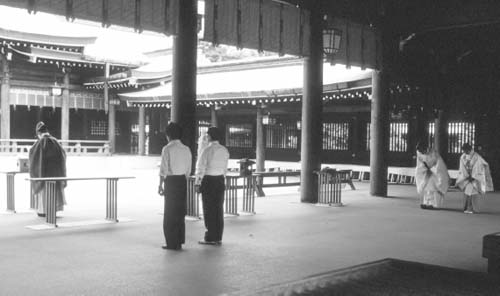ShintoMembership, Community, Diversity |
Are there any especially important Shinto holy places? |
One of the most striking features of Shinto tradition is the intuition of the world’s pervasive sacredness. Wherever the kami are, there is holiness—and that means just about everywhere people are willing to look carefully. Places where the kami dwell are called otabisho, “stages on a journey,” and are not necessarily identified with shrine buildings. Certain natural settings stand out as particularly potent. Mountains, waterfalls, caves, and trees have attracted Japan’s spiritual athletes (ascetics) and pilgrims over the centuries. Mount Fuji remains a revered symbol of natural perfection and beauty, and pilgrims still consider a hike to the volcano’s summit spiritually uplifting. On a clear winter’s day you can occasionally glimpse Fuji’s symmetrical slopes and snowy cap from taller buildings in Tokyo, sixty miles away, and it is easy to see how the mountain has assumed such symbolic importance.
In addition to countless holy places left as close to their natural states as possible, sacred architecture marks many others as sacred. “Founding stories” (engi) record how Shinto communities have chosen certain sites. These mythic tales tell how, for example, a deity went looking for a suitable dwelling and decided at last on one perfect spot. Amaterasu is said to have revealed in a dream to an imperial princess of old that she wanted her shrine built at Ise. Even into relatively recent times, Shinto tradition has considered such hierophanies (sacred manifestations) important explanations as to why certain places are high on the ladder of sanctity and power. But Shinto has not been associated with holy cities as have traditions like Hinduism and Islam, for example. Shinto tradition has not associated the kami so much with urban settings as with pristine nature. Some major shrines, like Kyoto’s Heian Jingu, have arisen conspicuously in the midst of bustling urban areas, showing a surprisingly public face. But most represent the cultivation of holy serenity in an increasingly disquieted world. Major publications list shrines according to their popularity and reputation for spiritual success stories, rating shrines according to particular categories of greatest interest, such as healing, help on examinations, good starts in new businesses, and fertility.

Two young men seek a blessing on a new business venture at Tokyo’s Meiji Jingu. At left is the principal priest, while at right the assistant priest and the miko (deaconess) bow.
